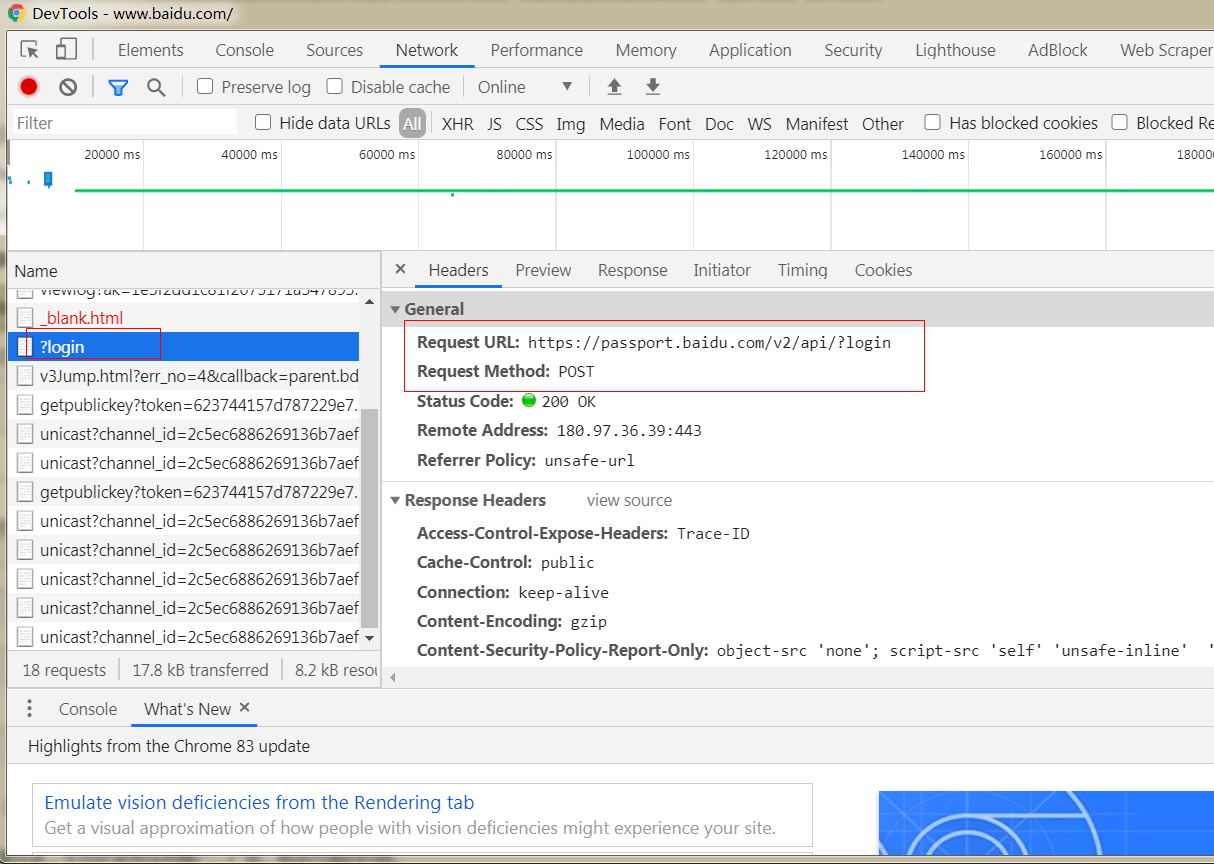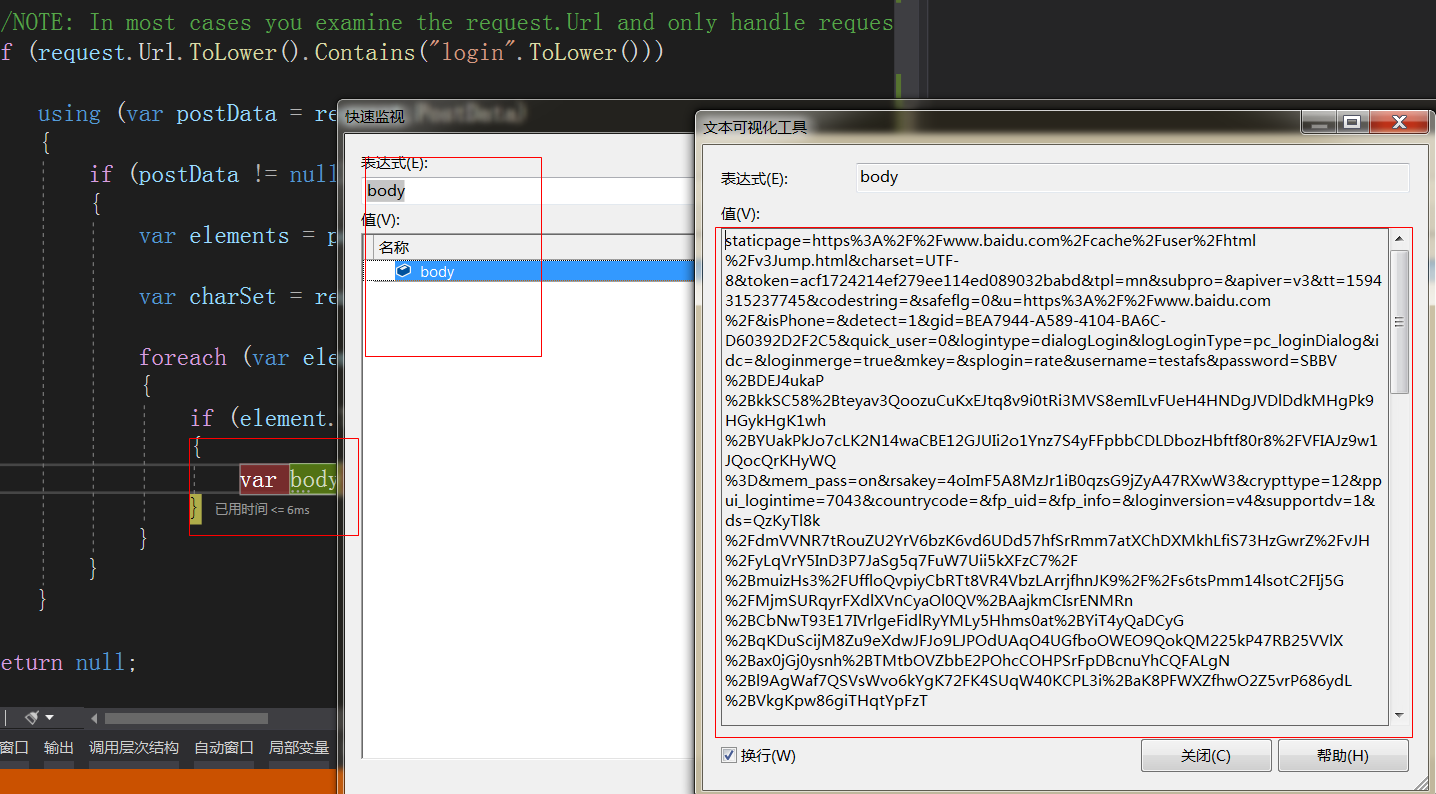WinForm窗体程序中使用CefSharp获取加载后的资源、截取request参数、拦截response数据、注入jquery文件和js代码(2)-截取request参数
源码地址:源代码csdn 或者底部qq问我要
四、cefsharp截取request参数
所有的request数据都可以在接口类IRequestHandler的方法中获取到,不过要先实现这些方法。
1、添加类 RequestHandler,继承IRequestHandler,实现接口中的各种方法
public class RequestHandler : IRequestHandler
{
/// <inheritdoc/>
bool IRequestHandler.OnBeforeBrowse(IWebBrowser chromiumWebBrowser, IBrowser browser, IFrame frame, IRequest request, bool userGesture, bool isRedirect)
{
return OnBeforeBrowse(chromiumWebBrowser, browser, frame, request, userGesture, isRedirect);
}
/// <summary>
/// Called before browser navigation. If the navigation is allowed <see cref="IWebBrowser.FrameLoadStart"/> and
/// <see cref="IWebBrowser.FrameLoadEnd"/>
/// will be called. If the navigation is canceled <see cref="IWebBrowser.LoadError"/> will be called with an ErrorCode value of
/// <see cref="CefErrorCode.Aborted"/>.
/// </summary>
/// <param name="chromiumWebBrowser">the ChromiumWebBrowser control.</param>
/// <param name="browser">the browser object.</param>
/// <param name="frame">The frame the request is coming from.</param>
/// <param name="request">the request object - cannot be modified in this callback.</param>
/// <param name="userGesture">The value will be true if the browser navigated via explicit user gesture (e.g. clicking a link) or
/// false if it navigated automatically (e.g. via the DomContentLoaded event).</param>
/// <param name="isRedirect">has the request been redirected.</param>
/// <returns>
/// Return true to cancel the navigation or false to allow the navigation to proceed.
/// </returns>
protected virtual bool OnBeforeBrowse(IWebBrowser chromiumWebBrowser, IBrowser browser, IFrame frame, IRequest request, bool userGesture, bool isRedirect)
{
return false;
}
/// <inheritdoc/>
bool IRequestHandler.OnOpenUrlFromTab(IWebBrowser chromiumWebBrowser, IBrowser browser, IFrame frame, string targetUrl,
WindowOpenDisposition targetDisposition, bool userGesture)
{
return OnOpenUrlFromTab(chromiumWebBrowser, browser, frame, targetUrl, targetDisposition, userGesture);
}
/// <summary>
/// Called on the UI thread before OnBeforeBrowse in certain limited cases where navigating a new or different browser might be
/// desirable. This includes user-initiated navigation that might open in a special way (e.g. links clicked via middle-click or
/// ctrl + left-click) and certain types of cross-origin navigation initiated from the renderer process (e.g. navigating the top-
/// level frame to/from a file URL).
/// </summary>
/// <param name="chromiumWebBrowser">the ChromiumWebBrowser control.</param>
/// <param name="browser">the browser object.</param>
/// <param name="frame">The frame object.</param>
/// <param name="targetUrl">target url.</param>
/// <param name="targetDisposition">The value indicates where the user intended to navigate the browser based on standard
/// Chromium behaviors (e.g. current tab, new tab, etc).</param>
/// <param name="userGesture">The value will be true if the browser navigated via explicit user gesture (e.g. clicking a link) or
/// false if it navigated automatically (e.g. via the DomContentLoaded event).</param>
/// <returns>
/// Return true to cancel the navigation or false to allow the navigation to proceed in the source browser's top-level frame.
/// </returns>
protected virtual bool OnOpenUrlFromTab(IWebBrowser chromiumWebBrowser, IBrowser browser, IFrame frame, string targetUrl,
WindowOpenDisposition targetDisposition, bool userGesture)
{
return false;
}
/// <inheritdoc/>
IResourceRequestHandler IRequestHandler.GetResourceRequestHandler(IWebBrowser chromiumWebBrowser, IBrowser browser, IFrame frame, IRequest request, bool isNavigation, bool isDownload, string requestInitiator, ref bool disableDefaultHandling)
{
return GetResourceRequestHandler(chromiumWebBrowser, browser, frame, request, isNavigation, isDownload, requestInitiator, ref disableDefaultHandling);
}
/// <summary>
/// Called on the CEF IO thread before a resource request is initiated.
/// </summary>
/// <param name="chromiumWebBrowser">the ChromiumWebBrowser control.</param>
/// <param name="browser">represent the source browser of the request.</param>
/// <param name="frame">represent the source frame of the request.</param>
/// <param name="request">represents the request contents and cannot be modified in this callback.</param>
/// <param name="isNavigation">will be true if the resource request is a navigation.</param>
/// <param name="isDownload">will be true if the resource request is a download.</param>
/// <param name="requestInitiator">is the origin (scheme + domain) of the page that initiated the request.</param>
/// <param name="disableDefaultHandling">[in,out] to true to disable default handling of the request, in which case it will need
/// to be handled via <see cref="IResourceRequestHandler.GetResourceHandler"/> or it will be canceled.</param>
/// <returns>
/// To allow the resource load to proceed with default handling return null. To specify a handler for the resource return a
/// <see cref="IResourceRequestHandler"/> object. If this callback returns null the same method will be called on the associated
/// <see cref="IRequestContextHandler"/>, if any.
/// </returns>
protected virtual IResourceRequestHandler GetResourceRequestHandler(IWebBrowser chromiumWebBrowser, IBrowser browser, IFrame frame, IRequest request, bool isNavigation, bool isDownload, string requestInitiator, ref bool disableDefaultHandling)
{
return null;
}
/// <inheritdoc/>
bool IRequestHandler.GetAuthCredentials(IWebBrowser chromiumWebBrowser, IBrowser browser, string originUrl, bool isProxy, string host,
int port, string realm, string scheme, IAuthCallback callback)
{
return GetAuthCredentials(chromiumWebBrowser, browser, originUrl, isProxy, host, port, realm, scheme, callback);
}
/// <summary>
/// Called when the browser needs credentials from the user.
/// </summary>
/// <param name="chromiumWebBrowser">The ChromiumWebBrowser control.</param>
/// <param name="browser">the browser object.</param>
/// <param name="originUrl">is the origin making this authentication request.</param>
/// <param name="isProxy">indicates whether the host is a proxy server.</param>
/// <param name="host">hostname.</param>
/// <param name="port">port number.</param>
/// <param name="realm">realm.</param>
/// <param name="scheme">scheme.</param>
/// <param name="callback">Callback interface used for asynchronous continuation of authentication requests.</param>
/// <returns>
/// Return true to continue the request and call <see cref="IAuthCallback.Continue(string, string)"/> when the authentication
/// information is available. Return false to cancel the request.
/// </returns>
protected virtual bool GetAuthCredentials(IWebBrowser chromiumWebBrowser, IBrowser browser, string originUrl, bool isProxy, string host,
int port, string realm, string scheme, IAuthCallback callback)
{
callback.Dispose();
return false;
}
/// <inheritdoc/>
bool IRequestHandler.OnQuotaRequest(IWebBrowser chromiumWebBrowser, IBrowser browser, string originUrl, long newSize,
IRequestCallback callback)
{
return OnQuotaRequest(chromiumWebBrowser, browser, originUrl, newSize, callback);
}
/// <summary>
/// Called when JavaScript requests a specific storage quota size via the webkitStorageInfo.requestQuota function. For async
/// processing return true and execute <see cref="IRequestCallback.Continue"/> at a later time to grant or deny the request or
/// <see cref="IRequestCallback.Cancel"/> to cancel.
/// </summary>
/// <param name="chromiumWebBrowser">The ChromiumWebBrowser control.</param>
/// <param name="browser">the browser object.</param>
/// <param name="originUrl">the origin of the page making the request.</param>
/// <param name="newSize">is the requested quota size in bytes.</param>
/// <param name="callback">Callback interface used for asynchronous continuation of url requests.</param>
/// <returns>
/// Return false to cancel the request immediately. Return true to continue the request and call
/// <see cref="IRequestCallback.Continue"/> either in this method or at a later time to grant or deny the request.
/// </returns>
protected virtual bool OnQuotaRequest(IWebBrowser chromiumWebBrowser, IBrowser browser, string originUrl, long newSize,
IRequestCallback callback)
{
callback.Dispose();
return false;
}
/// <inheritdoc/>
bool IRequestHandler.OnCertificateError(IWebBrowser chromiumWebBrowser, IBrowser browser, CefErrorCode errorCode, string requestUrl,
ISslInfo sslInfo, IRequestCallback callback)
{
return OnCertificateError(chromiumWebBrowser, browser, errorCode, requestUrl, sslInfo, callback);
}
/// <summary>
/// Called to handle requests for URLs with an invalid SSL certificate. Return true and call
/// <see cref="IRequestCallback.Continue"/> either in this method or at a later time to continue or cancel the request.
/// If CefSettings.IgnoreCertificateErrors is set all invalid certificates will be accepted without calling this method.
/// </summary>
/// <param name="chromiumWebBrowser">the ChromiumWebBrowser control.</param>
/// <param name="browser">the browser object.</param>
/// <param name="errorCode">the error code for this invalid certificate.</param>
/// <param name="requestUrl">the url of the request for the invalid certificate.</param>
/// <param name="sslInfo">ssl certificate information.</param>
/// <param name="callback">Callback interface used for asynchronous continuation of url requests. If empty the error cannot be
/// recovered from and the request will be canceled automatically.</param>
/// <returns>
/// Return false to cancel the request immediately. Return true and use <see cref="IRequestCallback"/> to execute in an async
/// fashion.
/// </returns>
protected virtual bool OnCertificateError(IWebBrowser chromiumWebBrowser, IBrowser browser, CefErrorCode errorCode, string requestUrl,
ISslInfo sslInfo, IRequestCallback callback)
{
callback.Dispose();
return false;
}
/// <inheritdoc/>
bool IRequestHandler.OnSelectClientCertificate(IWebBrowser chromiumWebBrowser, IBrowser browser, bool isProxy, string host, int port,
X509Certificate2Collection certificates, ISelectClientCertificateCallback callback)
{
return OnSelectClientCertificate(chromiumWebBrowser, browser, isProxy, host, port, certificates, callback);
}
/// <summary>
/// Called when the browser needs user to select Client Certificate for authentication requests (eg. PKI authentication).
/// </summary>
/// <param name="chromiumWebBrowser">The ChromiumWebBrowser control.</param>
/// <param name="browser">the browser object.</param>
/// <param name="isProxy">indicates whether the host is a proxy server.</param>
/// <param name="host">hostname.</param>
/// <param name="port">port number.</param>
/// <param name="certificates">List of Client certificates for selection.</param>
/// <param name="callback">Callback interface used for asynchronous continuation of client certificate selection for
/// authentication requests.</param>
/// <returns>
/// Return true to continue the request and call ISelectClientCertificateCallback.Select() with the selected certificate for
/// authentication. Return false to use the default behavior where the browser selects the first certificate from the list.
///
/// </returns>
protected virtual bool OnSelectClientCertificate(IWebBrowser chromiumWebBrowser, IBrowser browser, bool isProxy, string host, int port,
X509Certificate2Collection certificates, ISelectClientCertificateCallback callback)
{
callback.Dispose();
return false;
}
/// <inheritdoc/>
void IRequestHandler.OnPluginCrashed(IWebBrowser chromiumWebBrowser, IBrowser browser, string pluginPath)
{
OnPluginCrashed(chromiumWebBrowser, browser, pluginPath);
}
/// <summary>
/// Called when a plugin has crashed.
/// </summary>
/// <param name="chromiumWebBrowser">the ChromiumWebBrowser control.</param>
/// <param name="browser">the browser object.</param>
/// <param name="pluginPath">path of the plugin that crashed.</param>
protected virtual void OnPluginCrashed(IWebBrowser chromiumWebBrowser, IBrowser browser, string pluginPath)
{
}
/// <inheritdoc/>
void IRequestHandler.OnRenderViewReady(IWebBrowser chromiumWebBrowser, IBrowser browser)
{
OnRenderViewReady(chromiumWebBrowser, browser);
}
/// <summary>
/// Called on the CEF UI thread when the render view associated with browser is ready to receive/handle IPC messages in the
/// render process.
/// </summary>
/// <param name="chromiumWebBrowser">The ChromiumWebBrowser control.</param>
/// <param name="browser">the browser object.</param>
protected virtual void OnRenderViewReady(IWebBrowser chromiumWebBrowser, IBrowser browser)
{
}
/// <inheritdoc/>
void IRequestHandler.OnRenderProcessTerminated(IWebBrowser chromiumWebBrowser, IBrowser browser, CefTerminationStatus status)
{
OnRenderProcessTerminated(chromiumWebBrowser, browser, status);
}
/// <summary>
/// Called when the render process terminates unexpectedly.
/// </summary>
/// <param name="chromiumWebBrowser">The ChromiumWebBrowser control.</param>
/// <param name="browser">the browser object.</param>
/// <param name="status">indicates how the process terminated.</param>
protected virtual void OnRenderProcessTerminated(IWebBrowser chromiumWebBrowser, IBrowser browser, CefTerminationStatus status)
{
}
/// <inheritdoc/>
void IRequestHandler.OnDocumentAvailableInMainFrame(IWebBrowser chromiumWebBrowser, IBrowser browser)
{
OnDocumentAvailableInMainFrame(chromiumWebBrowser, browser);
}
/// <summary>
/// Called on the CEF UI thread when the window.document object of the main frame has been created.
/// </summary>
/// <param name="chromiumWebBrowser">the ChromiumWebBrowser control</param>
/// <param name="browser">the browser object</param>
protected virtual void OnDocumentAvailableInMainFrame(IWebBrowser chromiumWebBrowser, IBrowser browser)
{
}
}
2、新建WinFormsRequestHandler类,再继承RequestHandler类,在WinFormsRequestHandler类中来写具体的获取request参数方法
比如,要获取百度登录的post参数
先F12查看此方法名称为login

WinFormsRequestHandler类中重写覆盖父类中的方法GetResourceRequestHandler,并且只拦截请求url中有login名称的请求
public class WinFormsRequestHandler : RequestHandler
{
protected override IResourceRequestHandler GetResourceRequestHandler(IWebBrowser chromiumWebBrowser, IBrowser browser, IFrame frame, IRequest request, bool isNavigation, bool isDownload, string requestInitiator, ref bool disableDefaultHandling)
{
//NOTE: In most cases you examine the request.Url and only handle requests you are interested in
if (request.Url.ToLower().Contains("login".ToLower()))
{
using (var postData = request.PostData)
{
if (postData != null)
{
var elements = postData.Elements;
var charSet = request.GetCharSet();
foreach (var element in elements)
{
if (element.Type == PostDataElementType.Bytes)
{
var body = element.GetBody(charSet);
}
}
}
}
}
return null;
}
}
3、要在初始化cefsharp的地方,指向request请求的具体实现
public static string url = "https://www.baidu.com";//设置进入网页
public ChromiumWebBrowser browser = new ChromiumWebBrowser(url);//初始化cefsharp浏览器
public Form1()
{
InitializeComponent();
browser.Dock = DockStyle.Fill;//设置填充满窗体
this.Controls.Add(browser);//把cefsharp加入到窗体中
browser.RequestHandler = new WinFormsRequestHandler();//request请求的具体实现
}
4、调试运行,在步骤2的body中就可以获取到request的参数。再用&分割就可以得到各个参数






 浙公网安备 33010602011771号
浙公网安备 33010602011771号